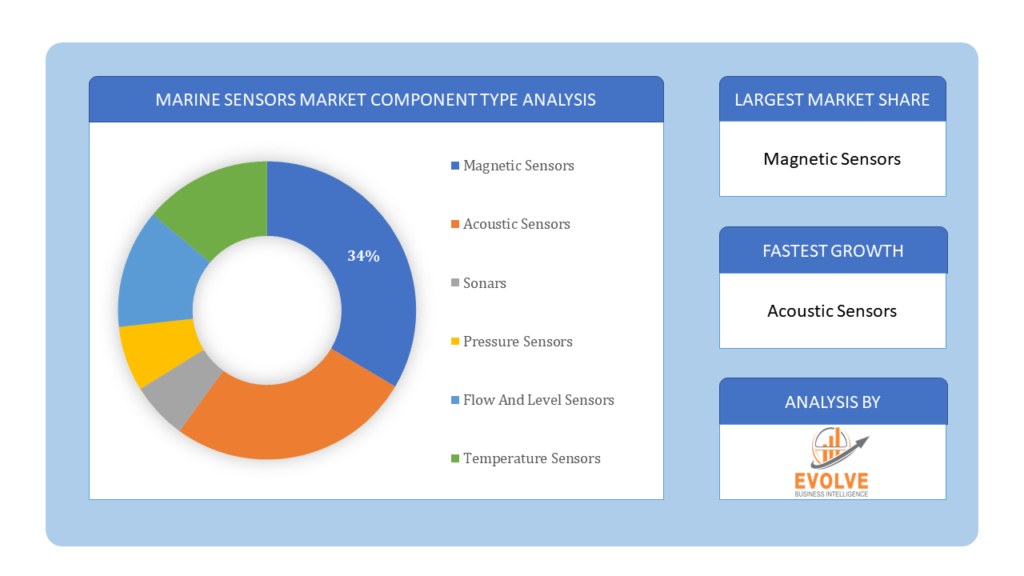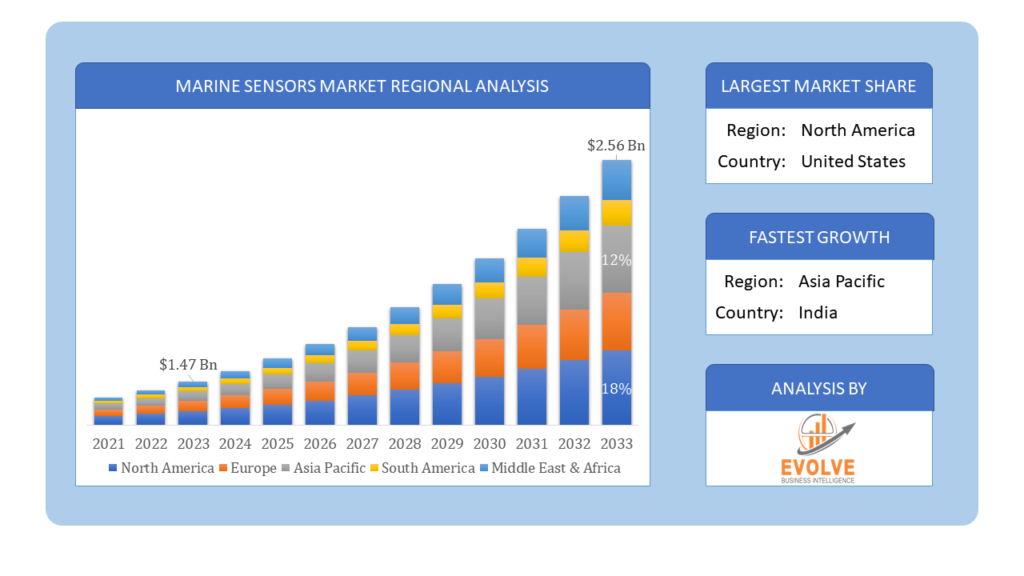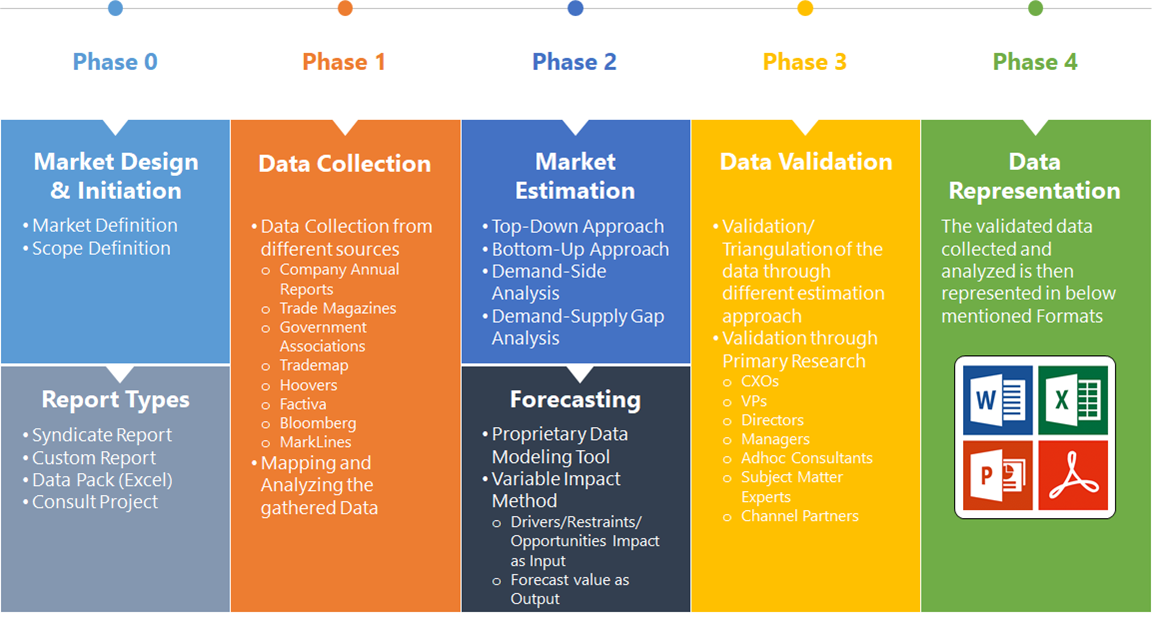Marine Sensors Market Overview
The Marine Sensors Market Size is expected to reach USD 2.56 Billion by 2033. The Marine Sensors Market industry size accounted for USD 1.47 Billion in 2023 and is expected to expand at a compound annual growth rate (CAGR) of 6.41% from 2023 to 2033. The Marine Sensors Market refers to the global industry involved in the development, production, and sale of sensors specifically designed for marine applications. These sensors are used to monitor and measure various parameters in marine environments, including water quality, temperature, salinity, pressure, currents, and biological activity. They play a crucial role in marine research, environmental monitoring, navigation, defense, and the operation of marine vessels and offshore structures.
The Marine Sensors Market is driven by increasing concerns about marine conservation, advancements in sensor technology, the need for accurate and real-time data in marine operations, and the expansion of marine research and exploration activities.
Global Marine Sensors Market Synopsis
The COVID-19 pandemic had a significant impact on the Marine Sensors Market. The pandemic led to significant disruptions in global supply chains, affecting the production and delivery of marine sensors. Manufacturing facilities faced shutdowns or operated at reduced capacity, leading to delays and shortages of critical components. Global shipping and marine traffic experienced a slowdown due to lockdown measures and reduced economic activity. This decrease in marine operations impacted the demand for navigation and monitoring sensors. The pandemic accelerated the adoption of remote and automated monitoring solutions. Marine sensors capable of providing real-time data and supporting remote operations became more critical, leading to a potential increase in demand for advanced sensor technologies. The pandemic highlighted the importance of environmental monitoring and conservation. As a result, there has been a renewed focus on understanding and protecting marine ecosystems, which could drive long-term demand for marine sensors. The need for improved data collection and analysis during the pandemic spurred innovations in sensor technology. Advances in miniaturization, data accuracy, and connectivity have enhanced the capabilities of marine sensors.
Marine Sensors Market Dynamics
The major factors that have impacted the growth of Marine Sensors Market are as follows:
Drivers:
Ø Advancements in Sensor Technology
Continuous technological advancements in sensor design, including improvements in accuracy, miniaturization, and connectivity, are driving the market. Enhanced capabilities of sensors make them more effective and reliable for various marine applications, leading to increased adoption. Increased investment in marine research and exploration activities by governments, research institutions, and private organizations boosts the demand for marine sensors. These sensors are vital for studying oceanographic phenomena, marine biology, and underwater geology. The need to monitor and understand the impacts of climate change on marine environments drives the use of marine sensors. These sensors help in collecting data on sea-level rise, ocean temperature changes, and other climate-related variables, aiding in climate modeling and mitigation efforts.
Restraint:
- Perception of High Cost of Sensors
Advanced marine sensors can be expensive to develop, produce, and maintain. The high cost can be a barrier for small and medium-sized enterprises (SMEs) and research institutions with limited budgets. The collection and transmission of sensitive environmental and operational data can raise concerns about data privacy and security. Ensuring the protection of this data from unauthorized access and cyber threats is crucial and can pose significant challenges.
Opportunity:
⮚ Blue Economy Development
The blue economy, which emphasizes the sustainable use of ocean resources for economic growth, offers opportunities for marine sensors. Sectors such as aquaculture, marine biotechnology, and coastal tourism can benefit from advanced sensor technologies for monitoring and managing marine resources. Increasing concerns about maritime safety and security drive the demand for sensors used in naval operations, underwater surveillance, and threat detection. Developing sensors that enhance situational awareness and security can open new market opportunities. There is an increasing emphasis on sustainable practices in the maritime industry. Sensors that support sustainable fishing, reduce bycatch, and monitor the impact of human activities on marine ecosystems can find growing demand.
Marine Sensors Market Segment Overview
By Component Type
 Based on Component Type, the market is segmented based on Magnetic Sensors, Acoustic Sensors, Sonars, Pressure Sensors, Flow And Level Sensors and Temperature Sensors. The flow and levels sensors category dominates the market with the largest. Flow and level sensors are integral for managing liquid cargo, ballast systems, and ensuring vessel stability. They are commonly employed in commercial shipping, oil and gas exploration, and maritime logistics. Acoustic sensors play a vital role in underwater communication, navigation, and detection. They are used for tasks such as sonar systems, underwater communication, and detecting underwater objects, including submarines, making them indispensable for defense, research, and commercial purposes.
Based on Component Type, the market is segmented based on Magnetic Sensors, Acoustic Sensors, Sonars, Pressure Sensors, Flow And Level Sensors and Temperature Sensors. The flow and levels sensors category dominates the market with the largest. Flow and level sensors are integral for managing liquid cargo, ballast systems, and ensuring vessel stability. They are commonly employed in commercial shipping, oil and gas exploration, and maritime logistics. Acoustic sensors play a vital role in underwater communication, navigation, and detection. They are used for tasks such as sonar systems, underwater communication, and detecting underwater objects, including submarines, making them indispensable for defense, research, and commercial purposes.
By Application
Based on Application, the market segment has been divided into the Command And Control, Intelligence And Reconnaissance and Target Recognition. The Intelligence And Reconnaissance segment dominant the market. The Intelligence and Reconnaissance segment within the Marine Sensors Market is focused on sensors and systems used for gathering, processing, and analyzing information to support military, defense, and security operations. This segment is critical for enhancing situational awareness, detecting potential threats, and ensuring maritime security.
Global Marine Sensors Market Regional Analysis
Based on region, the global Marine Sensors Market has been divided into North America, Europe, Asia-Pacific, the Middle East & Africa, and Latin America. North America is projected to dominate the use of the Marine Sensors Market followed by the Asia-Pacific and Europe regions.
 Marine Sensors North America Market
Marine Sensors North America Market
North America holds a dominant position in the Marine Sensors Market. The U.S. and Canada lead the region with significant investments in marine research and environmental monitoring. Focus on advanced sensor technologies for national security and defense applications. Strong regulatory support for environmental conservation and climate change mitigation.
Marine Sensors Asia-Pacific Market
The Asia-Pacific region has indeed emerged as the fastest-growing market for the Marine Sensors Market industry. China, Japan, and South Korea are key players with substantial investments in marine technology and infrastructure. Growing demand for sensors in fisheries, aquaculture, and maritime navigation. Regional initiatives to address marine pollution and enhance environmental monitoring.
Competitive Landscape
The global Marine Sensors Market is highly competitive, with numerous players offering a wide range of software solutions. The competitive landscape is characterized by the presence of established companies, as well as emerging startups and niche players. To increase their market position and attract a wide consumer base, the businesses are employing various strategies, such as product launches, and strategic alliances.
Prominent Players:
- Gill Instruments
- Honeywell International Inc.
- Lockheed Martin Corporation
- NRG Systems Inc.
- Raytheon Company
- Saab AB
- Thales Group
- BAE Systems
- Kongsberg
- Thales Group
Key Development
In September 2023, HBK expands its line of sensors by adding MicroStrain acquisition. MicroStrain is a manufacturer of high-precision wireless and inertial sensing solutions for the automation, mobility, and unmanned vehicle industries.
Scope of the Report
Global Marine Sensors Market, by Component Type
- Magnetic Sensors
- Acoustic Sensors
- Sonars
- Pressure Sensors
- Flow And Level Sensors
- Temperature Sensors
Global Marine Sensors Market, by Application
- Command And Control
- Intelligence And Reconnaissance
- Target Recognition
Global Marine Sensors Market, by Region
- North America
- US
- Canada
- Mexico
- Europe
- UK
- Germany
- France
- Italy
- Spain
- Benelux
- Nordic
- Rest of Europe
- Asia Pacific
- China
- Japan
- South Korea
- Indonesia
- Austalia
- Malaysia
- India
- Rest of Asia Pacific
- South America
- Brazil
- Argentina
- Rest of South America
- Middle East & Africa
- Saudi Arabia
- UAE
- Egypt
- South Africa
- Rest of Middle East & Africa
| Parameters | Indicators |
|---|---|
| Market Size | 2033: $2.56 Billion/strong> |
| CAGR | 6.41% CAGR (2023-2033) |
| Base year | 2022 |
| Forecast Period | 2023-2033 |
| Historical Data | 2021 |
| Report Coverage | Revenue Forecast, Competitive Landscape, Growth Factors, and Trends |
| Key Segmentations | Component Type, Application |
| Geographies Covered | North America, Europe, Asia-Pacific, Latin America, Middle East, Africa |
| Key Vendors | Gill Instruments, Honeywell International Inc., Lockheed Martin Corporation, NRG Systems Inc., Raytheon Company, Saab AB, Thales Group, BAE Systems, Kongsberg and Thales Group. |
| Key Market Opportunities | • Blue Economy Development • Growing Maritime Safety and Security Needs |
| Key Market Drivers | • Advancements in Sensor Technology • Climate Change and Weather Monitoring |
REPORT CONTENT BRIEF:
- High-level analysis of the current and future Marine Sensors Market trends and opportunities
- Detailed analysis of current market drivers, restraining factors, and opportunities in the future
- Marine Sensors Market historical market size for the year 2021, and forecast from 2023 to 2033
- Marine Sensors Market share analysis at each product level
- Competitor analysis with detailed insight into its product segment, Government & Defense strength, and strategies adopted.
- Identifies key strategies adopted including product launches and developments, mergers and acquisitions, joint ventures, collaborations, and partnerships as well as funding taken and investment done, among others.
- To identify and understand the various factors involved in the global Marine Sensors Market affected by the pandemic
- To provide a detailed insight into the major companies operating in the market. The profiling will include the Government & Defense health of the company’s past 2-3 years with segmental and regional revenue breakup, product offering, recent developments, SWOT analysis, and key strategies.





